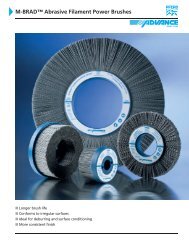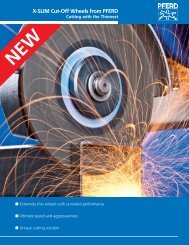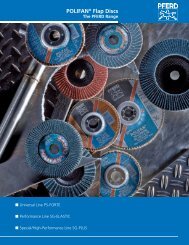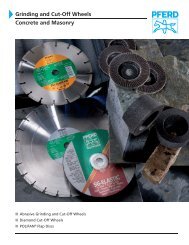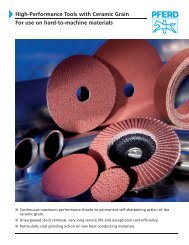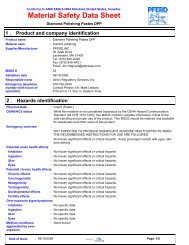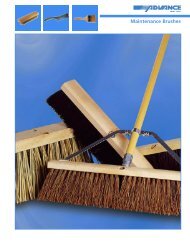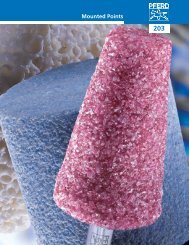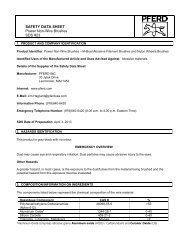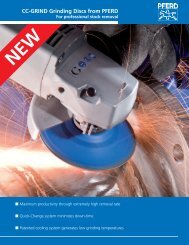Power Wire Brushes - Pferd
Power Wire Brushes - Pferd
Power Wire Brushes - Pferd
You also want an ePaper? Increase the reach of your titles
YUMPU automatically turns print PDFs into web optimized ePapers that Google loves.
<strong>Power</strong> <strong>Brushes</strong><br />
Operating Procedures<br />
Determining the<br />
Recommended Speed<br />
➊ Select brush type.<br />
➋ Read recommended surface speed.<br />
➌ Determine the speed using the brush<br />
diameter and surface speed.<br />
➊<br />
➋<br />
End brushes 2,500 - 4,000 SFPM<br />
Cup brushes<br />
8,000 - 10,000 SFPM<br />
Wheel brushes /<br />
see<br />
Bevel cup brushes<br />
adjacent chart<br />
The colour bars correspond to the colour code<br />
of the filament materials (see page 3).<br />
➋ Recommended Surface Speeds for Brushing Applications<br />
Surface Feet Per Minute [SFPM]<br />
Application 1,250 2,000 2,750 3,500 4,250 5,000 5,750 6,500 7,250 8,000 8,750 9,500<br />
Burr Removal/<br />
Edge Blending<br />
Scale Removal<br />
Surface Polishing<br />
Weld Cleaning<br />
Problems and Solutions<br />
Problem<br />
Inadequate<br />
brushing<br />
action<br />
Excessively<br />
strong<br />
brushing<br />
action<br />
Surface is<br />
too rough<br />
and irregular<br />
Excessively<br />
fine finish/<br />
surface<br />
appears too<br />
polished<br />
Secondary<br />
burr formation<br />
Solution<br />
■■Increase RPM or use larger<br />
brush diameter at same RPM.<br />
■■Use a brush with shorter trim.<br />
■■Select a brush with thicker<br />
filaments.<br />
■■Reduce RPM or use a smaller<br />
brush diameter at same RPM.<br />
■■Reduce contact pressure.<br />
■■Use a brush with longer trim.<br />
■■Select a brush with thinner<br />
filaments.<br />
■■Use a wider brush or a longer<br />
trim length<br />
■■Select a brush with thinner<br />
filaments.<br />
■■Increase RPM.<br />
■■Select a brush with thicker<br />
filaments.<br />
■■Use a brush with shorter trim.<br />
■■Reduce RPM.<br />
■■Change brush-to-workpiece<br />
operating angle.<br />
■■Use a brush with shorter trim.<br />
■■Select a brush with thicker<br />
filaments.<br />
Maximum Performance<br />
Recommendations<br />
Pressure: Work is accomplished on wire brushes<br />
when the tips of the filament come into contact<br />
with the workpiece. The tips are the only sharp<br />
point on the filament. Avoid excessive pressure<br />
when using a power brush. Excessive pressure<br />
causes overbending of the filaments and heat<br />
build-up resulting in filament breakage, rapid<br />
dulling, and reduced brush life.<br />
CORRECT<br />
<strong>Wire</strong> tips are doing<br />
the work<br />
INCORRECT<br />
Excessive pressure can<br />
cause wire breakage<br />
RPM<br />
➌ Surface Speeds in Surface Feet per Minute [SFPM]<br />
Brush Diameter [Inches]<br />
2 3 4 5 6 8 10 12 14 15<br />
800 400 600 800 1,000 1,250 1,650 2,050 2,500 2,900 3,100<br />
1,150 600 900 1,200 1,500 1,800 2,400 3,000 3,600 4,200 4,500<br />
1,200 600 900 1,250 1,550 1,850 2,500 3,100 3,750 4,350 4,700<br />
1,750 900 1,350 1,800 2,250 2,700 3,650 4,550 5,450 6,400 6,850<br />
2,000 1,000 1,550 2,050 2,600 3,100 4,150 5,200 6,250 7,300 7,850<br />
2,400 1,250 1,850 2,500 3,100 3,750 5,000 6,250 7,500 8,750 9,400<br />
3,000 1,550 2,350 3,100 3,900 4,700 6,250 7,850 9,400 10,950 11,750<br />
3,450 1,800 2,700 3,600 4,500 5,400 7,200 9,000 10,800 12,600 13,500<br />
3,750 1,950 2,900 3,900 4,900 5,850 7,850 9,800 11,750<br />
4,000 2,050 3,100 4,150 5,200 6,250 8,350 10,450 12,550<br />
4,500 2,350 3,500 4,700 5,850 7,050 9,400 11,750 14,100<br />
5,000 2,600 3,900 5,200 6,500 7,850 10,450 13,050<br />
5,400 2,800 4,200 5,650 7,050 8,450 11,300<br />
6,000 3,100 4,700 6,250 7,850 9,400<br />
8,500 4,400 6,650 8,850 11,100<br />
9,000 4,700 7,050 9,400 11,750<br />
10,000 5,200 7,850 10,450 13,050<br />
12,000 6,250 9,400 12,550 15,700<br />
15,000 7,850 11,750 15,700 19,600<br />
18,000 9,400 14,100 18,800<br />
20,000 10,450 15,700 16,400<br />
Apply work to brush, or vice versa, in such a<br />
way that as much of the brush face as possible<br />
is in full contact with the workpiece. Applying<br />
the work to the side or edge of the brush will<br />
result in wire breakage and shorten brush life.<br />
Self-Sharpening:<br />
When using wire wheel brushes, periodically reverse<br />
the direction of rotation to take advantage<br />
of the self-sharpening action that will result. This<br />
may be accomplished by removing the brush<br />
from the spindle and turning it side for side, and<br />
remounting securely.<br />
Example:<br />
Crimped <strong>Wire</strong> Wheel, 6” Diameter<br />
Burr Removal<br />
Surface Speed: 5,400 SFPM<br />
Rotational Speed: 3,450 RPM<br />
SFPM =<br />
π x Diameter [Inches] x RPM<br />
12<br />
Spindle<br />
Remove Turn Remount<br />
PFERD ADVANCE BRUSH offers a line of TWIN-<br />
NUT stringer bead wheels which are designed<br />
to be reversed on a threaded spindle without<br />
interfering with the tool guard. This also takes<br />
advantage of the self-sharpening action of the<br />
wire. Please see page 29 for additional information<br />
on this product range.<br />
208<br />
CATALOGUE<br />
208 I<br />
PAGE<br />
13





